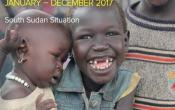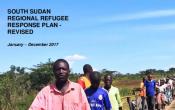South Sudan
Operation: South Sudan
Location
{"longitude":30,"latitude":7,"zoom_level":0}
Latest update of camps and office locations 21 Nov 2016. By clicking on the icons on the map, additional information is displayed.
Key Figures
| 2016 end-year results | |
| 350,000 | IDPs were reached through protection interventions |
| 272,000 | IDPs with specific vulnerabilities were assisted with core relief items and emergency shelters |
| 41,000 | refugee children enrolled in primary school |
| 31,000 | refugees received livelihood kits |
| 15,000 | refugee ID cards were issued |
| 11,000 | new refugee arrivals were registered and assisted with core relief items and shelters |
| 1 | new camp in Pamir was established with a capacity of 20,000 to accommodate new arrivals and relocate refugees in Parieng |
| 2017 planning figures | |
| 50,000 | vulnerable internally displaced households will receive core-relief items (CRIs) |
| 15,700 | displaced people with specific needs will receive support |
| 90% | of primary school-age refugee children will be enrolled in primary education |
| 80% | of households will have individual latrines |
| 40% | of households will receive durable shelters |
| <2% | Prevalence of Severe Acute Malnutrition is kept below 2% among children aged 6 to 59 months old, in line with the emergency standards |
| <0.5% | Mortality rate is kept below 0.5% among refugee children younger than 5 years old, in line with the emergency standard (per 1,000 children/month) |
Latest Updates and Related Links
Last Updated 18 September 2017
People of Concern
40%
Increase in
2016
2016
| 2016 | 2,870,538 |
| 2015 | 2,054,441 |
| 2014 | 2,093,729 |

[["Refugees",262560],["Asylum-seekers",1792],["IDPs",1853924],["Returned IDPs",752261],["Returned refugees",1]]
Loading ...
South Sudan
< Back
2016
{"categories":[2012,2013,2014,2015,2016,2017],"budget":[265.31204645,220.15274604,423.03014037,413.880856341,275.66821274,171.67261914],"expenditure":[153.3296072,159.68388729,142.04241824,140.46294415,126.30817887,null]}
{"categories":[2012,2013,2014,2015,2016,2017],"p1":[202.40813916,169.56500337,190.77653836,185.326305374,167.85975155,130.8740802],"p2":[2.99754561,9.31867217,8.77186352,6.53999141,4.79579352,1.49549201],"p3":[3.38841143,10.46680187,null,null,null,null],"p4":[56.51795025,30.80226863,223.48173849,222.014559557,103.01266767,39.30304693]}
{"categories":[2012,2013,2014,2015,2016,2017],"p1":[124.84168863,140.4070933,86.74189326,96.29588561,87.87085463,null],"p2":[1.34545828,4.03534842,3.76620376,2.11256854,2.54706187,null],"p3":[2.67775157,4.86436034,null,null,null,null],"p4":[24.46470872,10.37708523,51.53432122,42.05449,35.89026237,null]}
Loading ...
CHOOSE A YEAR
- 2014
- 2015
- 2016
- 2017
Working environment
Despite the signing of the Agreement on the Resolution of the Conflict in the Republic of South Sudan (ARCSS) in 2015, the humanitarian situation deteriorated further when violence erupted in Juba in July 2016 and the conflict spread across areas that had previously been relatively stable. The economic situation exacerbated, with the cost of living rising exponentially. Insecurity and logistical challenges posed constraints to the delivery of assistance. Proliferation of arms across the country and maintenance of the civilian character of asylum in the camps remained challenging.While South Sudan maintains an open door policy for refugee arrivals, the asylum conditions were affected by the conflict especially in greater Equatoria. Following security deterioration in Yei (southern part of the country), access to Lasu camp became impossible and all assistance, except for remote protection monitoring, was suspended in September 2016.
The year also witnessed a rise in tensions between refugee and host communities.
Population trends
- South Sudan hosted some 262,000 refugees with 92 per cent from Sudan, five per cent from the Democratic Republic of the Congo, two per cent from Ethiopia and one per cent from the Central African Republic. Some 90 per cent of refugees reside in camps in the north of the country.
- The number of internally displaced people (IDPs) in the country grew to more than 1.8 million. An estimated 300,000 people were newly displaced in the second half of the year. Some 238,000 IDPs are hosted in the UNMISS Protection of Civilian sites.
- The refugee arrivals in 2016 totalled 11,861 individuals, an increase of 12 per cent on arrival numbers from 2015, mostly due to intensified fighting in South Kordofan.
Achievements and impact
In cooperation with the Government and partners, UNHCR continued to deliver protection and assistance to over 262,000 refugees, supported efforts to prevent statelessness, and rendered protection-centred interventions for IDPs.Refugee response:
- Protection activities focused on reception, registration and documentation: more than 15,000 refugee identity cards were issued and 900 identity cards were replaced. Appropriate responses were provided to nearly 3,000 unaccompanied children and close to 890 reported cases of sexual gender-based violence incidents. Awareness-raising campaigns on the importance of the civilian character of the camps were carried out, and community participation and peaceful co-existence with the host communities were promoted.
- To accommodate new arrivals and address the need to relocate from the border, Pamir camp was officially opened in Unity State in September 2016with an initial capacity for 20,000 people.
- Multi-sectorial essentials services such as WASH, health, nutrition, education were provided in all refugee camps where access remained permissible. The health, nutrition and WASH indicators were applied according to relevant standards. Some 31,000 refugees received livelihood kits and agricultural land was secured for agricultural activities of refugees.
IDP response:
- UNHCR continued to lead the Protection Cluster and co-lead the Camp Coordination and Camp Management (CCCM) Cluster for the IDP response. UNHCR provided protection assistance through outreach, strengthening of community structures, counselling, identification of people with specific needs, targeted material assistance and/or referrals. UNHCR conducted 80 protection assessments, facilitated sexual gender-based violence training to 2,146 IDPs and 430 awareness-raising sessions. Close to 271,750 IDPs with specific vulnerabilities received material assistance including core relief items and emergency shelters. Overall, some 350,000 IDPs were reached in 2016.
Prevention of Statelessness
- Nationality certificates were issued to close to 2,200 individuals in close cooperation with the Department of Nationality, Passports and Immigration (DNPI).
Unmet needs
Substantial gaps remain in meeting the protection and assistance needs of refugees, IDPs and people at risk of statelessness, due to general insecurity across the country, lack of basic infrastructure/services and resource constraints.- Access to justice in most of the locations remains a challenge, due to the absence of adequate formal judicial structures.
- Gaps remain in the improvement of emergency shelters and other camp facilities: over 60 per cent of refugees remained in need of transitional shelters; teacher/pupil ratio persisted at 1:140. Solarisation for street lights and boreholes needs to be increased. More robust livelihoods and self-reliance interventions are required.
- Critical gaps remained in the coverage of IDP protection outreach activities, including profiling, focus group discussions, identification of and tailored response to vulnerable people and support to existing community structures. Interventions in addressing SGBV were not able to meet the tremendous needs, due to limited local capacity to respond to the needs of SGBV survivors and populations at risk in the capital, and non-existent in other parts of the country.
Since the outbreak of violence in December 2013, fighting has continued, especially in Unity, Upper Nile and Jonglei states, resulting in recurrent population displacement within the country and beyond. An IASC system-wide level 3 emergency declared in February 2014 remains in effect until the end of November 2015, when the situation in the country will be reviewed. By August 2015, the crisis had adversely affected over 265,000 refugees in the country, particularly those in the conflict-affected Upper Nile and Unity States.
While peace efforts continue, the humanitarian needs of an estimated 1.5 million internally displaced persons (IDPs) remain considerable, and protection concerns persist. Many parts of the country are difficult to access due to insecurity, poor road conditions and the long rainy season. UNHCR and partners have therefore endeavoured to pre-position NFI stocks.
UNHCR’s engagement in the IDP operation is being strategically realigned, in light of the operational reality and implementation capacity. The emergency shelter/NFI cluster will focus on addressing gaps identified through protection monitoring outside of IDP sites, rather than on the previous comprehensive approach. This operational adjustment, together with a lower population planning figure of 120,000 for 2016 (compared to 2015), has led to a reduction in estimated budgetary requirements for the South Sudan operation in 2016 and 2017.
In this context, UNHCR, in cooperation with the South Sudanese Commission for Refugee Affairs and operational partners, will continue to provide protection and multi-sectoral assistance for refugees, including emergency response, while ensuring effective leadership and coordination of the refugee response in the country. Increased attention will be placed on refugees’ self-reliance, including through new initiatives to promote livelihoods. Peaceful coexistence between host communities and refugees will be promoted. As part of inter-agency humanitarian efforts, UNHCR will also provide protection and assistance to IDPs through cluster coordination (Protection and CCCM) and protection delivery, especially in hard-to-reach areas.





